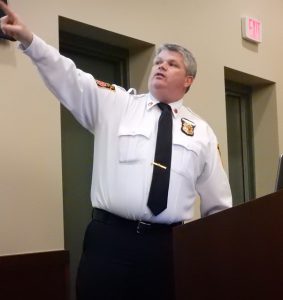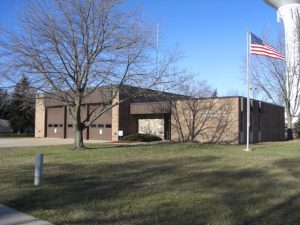Fire chief offers ‘sobering’ report

Plymouth Township Fire Department personnel raise the longest ladder the township currently owns (circled) at The Inn at St. Johns’ during a demonstration of an aerial ladder truck. Current fire department equipment conditions and response times were reported as “life- threatening” by Chief Dan Phillips. Photo by Don Howard
Feb. 16, 2017 PLYMOUTH EAGLE.
Plymouth Michigan News
Don Howard
Staff Writer

A sobering report presented by Plymouth Township Fire Chief Dan Phillips last week revealed emergency response times at a level now considered to be life-threatening in the township.
The current conditions, Phillips explained to the members of the Board of Trustees, have ravaged critical assets and are the result of years of staffing cuts and a failure to repair or replace dilapidated and neglected equipment
The last public report of such grave conditions was presented by former Fire Chief Mark Wendell in a 2013 letter to then Township Supervisor Richard Reaume. In Phillips’ dire report, presented during a board study session, he outlined a 50-percent decline in response times for the year 2016. Phillips maintains that up to the closing of the Lake Pointe Fire Station and severe fire personnel cutbacks, the department was able to average 4:13 minutes for emergency runs. The current 6:50 minute average response times, he said, are totally unacceptable, describing it as a life and death situation.
In January 2017, there were 240 fire-rescue incidents according to Phillips. Response times for the township are measured from the time of the 9-1-1 call until the first fire department medical/fire unit arrives on the scene of the emergency.
Medical experts and national standards agree there are virtually no chances of survival for a patient in cardiac arrest after 6 minutes – a time after which all body organs have stopped. Experts say 6 minutes is the determinate time limit in 99 percent of cases of patient survival.
In one documented case reported by The Eagle last year, help came too late for a unresponsive male in Lake Pointe when the rescue squad arrived 10 minutes after a 9-1-1 call. This incident was not an isolated case, according to official reports.
Phillips, who made the report at the request of the board members, said that because of the staffing cuts and neglect of equipment, he is forced to operate with a maximum of 18 firefighters and broken-down equipment. He said currently the fire department safety and res- cue gear is out of compliance with National Fire Protection Association (NFPA) safety recommendations. He said the 18 firefighters are spread over three shifts per day between the two township fire stations that are currently open. By contrast neighboring Northville Township has 27 full-time firefighters.
Phillips methodically reviewed the equipment situation, detailing the condition of obsolete air packs, old power-lift cots and outdated defibrillators. Phillips said of the two fire engines in service, one, a 1989 pumper is 28 years old and the tank is almost completely rusted and is not equipped to carry the Jaws-of-Life. He said the other pumper, a 1989 model, has a rusted undercarriage and is an open cab design that is not only unsafe but is now considered illegal. The truck, he said, has been known to fail to operate during emergency runs.

Township Supervisor Kurt Heise made a campaign promise to work to reopen the Lake Pointe Fire Station. Phillips estimated the immediate cost for that reopening at $590,000. He said an additional six full-time firefighters; a replacement ambulance; a fire engine; two-way radios; computers and some furniture would be necessary to implement the reopening. Phillips said should the township be successful in obtaining a SAFER grant for the required six additional firefighters, federal funds would pay $380,610 the first and second years. The township share would be $126,870 each year.
The hiring of additional firefighters and re-opening the Lake Pointe station would not address the absence of an aerial ladder truck, an expensive fire engine estimated to cost nearly $900,000. The township does not currently have an aerial ladder truck and cannot facilitate res- cues in more than a one-story building. Currently, Plymouth Township relies on Mutual Aid from other community fire departments in those situations, which adds to response times, according to Phillips.

For the past 20 years HVA (Huron Valley Ambulance) an Ann Arbor hospital transport agency, has been working in the township without a contract. HVA directly invoices either patients, Medicare, Medicaid, automobile insurance or health insurance for up to $720 for each medical response, regardless of the dual response by the township fire department. There is no required response time for HVA and all medical emergency calls to 9-1-1 are forwarded to HVA as part of a decades old agreement.
HVA frequently cannot comply with national standards for emergency response in a timely manner and frequently does not have an ambulance immediately available according to people knowledgeable of the operation. HVA often responds to township emergency runs from areas like Wixom and Novi, a 20-25 minute distance.
Phillips suggested the board members re-consider having the township fire department take sole responsibility for all emergency patient transport as is the situation in Canton and Northville townships and the City of Livonia, where their expanded emergency dispatch operation is a profit center.
Board members agreed to conduct a further review and said they already scheduled meetings with public safety officials from Northville Township to discuss possible joint operations.
Heise said he didn’t think it would be practical to renegotiate with the City of Plymouth for fire and emergency services, one of Phillips’ possible suggestions during his presentation.
“Plymouth city is a different category, paid on-call. It’s a different animal,” Heise said.
Plymouth Voice.


